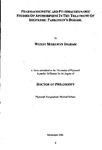PHARMACOKINETIC AND PHARMCODYNAMIC STUDIES OF APOMORPHINE IN THE TREATMENT OF IDIOPATHIC PARKINSON'S DISEASE
| dc.contributor.author | INGRAM, WENDY MEREWYN | |
| dc.contributor.other | Peninsula Medical School | en_US |
| dc.date.accessioned | 2013-11-22T16:03:49Z | |
| dc.date.available | 2013-11-22T16:03:49Z | |
| dc.date.issued | 2001 | |
| dc.identifier | NOT AVAILABLE | en_US |
| dc.identifier.uri | http://hdl.handle.net/10026.1/2824 | |
| dc.description.abstract |
There were two aspects to the study of apomorphine in the treatment of Parkinson' s disease: (i) a clinical pharmacokinetic-pharmacodynamic (PK-PD) study was designed and implemented in response to the challenges of apomorphine dose-titration in Parkinson's disease, and in view of the scarcity of available literature on the PK-PD relationships of apomorphine in Parkinson's disease, (ii) the PK(and tolerability)of apomorphine dosing using novel delivery/formulation combinations were explored in view of the inherent limitations associated with the conventional (ie. subcutaneous) route of administration of apomorphine (e.g. cutaneous nodule formation, needle-phobia). An HPLC assay was developed for the quantification of apomorphine in plasma, and stability issues relating to sample storage and assay were investigated. With regards to the first aspect of the research, simultaneous PK-PD modelling was performed, using an effect compartment model to account for counterclockwise hysteresis in a sub-group of patients. According to the traditional two-stage approach to data analysis, mean (standard deviation) clearance following subcutaneous bolus was 2.2 (0.5) L/kg/h, (apparent) volume of distribution was 1.9 (0.8) L/kg, absorption half-life was 4.1 (2.1) minutes and elimination half-life was 69.5 (21.1)minutes (n=7). Equilibration half-life was estimated for two patients at 8.3 and 16.5 minutes. Focus was given to investigating the relevance of a potential correlation (which had previously been identified using in-house pilot data) between post-distributional apomorphine PK and apomorphine-induced anti-parkinsonian response in patients with Parkinson's disease. It was hypothesised that this particular correlation may be of use in a dose-optimisation scheme. However it was demonstrated that, in the patients studied, the concept could not be applied to apomorphine dose-optimisation. The novel delivery systems under scrutiny were: (i) Britaject® (Britannia Pharmaceuticals Ltd.) apomorphine formulation administered subcutaneously using a needle-free (jet) injector (J-TIP®, National Medical Products Inc.), (ii) an intranasal apomorphine powder formulation delivered using a turbospin insufflator (CDFS), and (iii) an apomorphine hydrogel co-polymer produced as a dosage-form for buccal delivery (Controlled Therapeutics (Scotland) Ltd.). As a result of this work, a rationale for subsequent development of the novel systems was provided. Indeed, the needle-free and buccal systems were, in their existing format, shown not to convey a net advantage over the existing system. However the intranasal formulation, with a mean (standard deviation) relative bioavailability of 41 (18)% (n=16) compared to subcutaneous bolus administration (and with a favourable outcome as regards to tolerability), was considered to be potentially suitable for further development. | en_US |
| dc.language.iso | en | en_US |
| dc.publisher | University of Plymouth | en_US |
| dc.title | PHARMACOKINETIC AND PHARMCODYNAMIC STUDIES OF APOMORPHINE IN THE TREATMENT OF IDIOPATHIC PARKINSON'S DISEASE | en_US |
| dc.type | Thesis | |
| plymouth.version | Full version | en_US |
| dc.identifier.doi | http://dx.doi.org/10.24382/3519 | |
| dc.identifier.doi | http://dx.doi.org/10.24382/3519 |
Files in this item
This item appears in the following Collection(s)
-
01 Research Theses Main Collection
Research Theses Main


